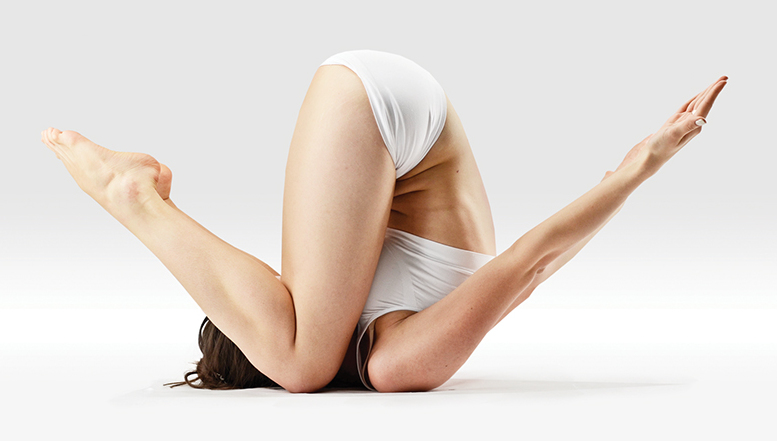Halasana on:
[Wikipedia]
[Google]
[Amazon]
 Halasana (; ) or Plough pose is an inverted asana in hatha yoga and modern yoga as exercise. Its variations include Karnapidasana with the knees by the ears, and Supta Konasana with the feet wide apart.
Halasana (; ) or Plough pose is an inverted asana in hatha yoga and modern yoga as exercise. Its variations include Karnapidasana with the knees by the ears, and Supta Konasana with the feet wide apart.
File:Arair champige a reil.png, The completed pose resembles a traditional plough.
File:Sritattvanidhi Lalangasana.jpg, ''Lāṇgalāsana'' in the ''Sritattvanidhi'' from the Mysore Palace, before 1868
File:Marguerite Agniel posing with her back arched and legs stret Wellcome V0048584.jpg, The health and beauty guru Marguerite Agniel in plough pose, c. 1928. Photograph by John de Mirjian
 Karnapidasana (ear-pressing pose) or Raja Halasana (royal plough pose) has the knees bent close to the head and grasped by the arms.
Parsva Halasana (sideways plough) has the body vertical, the trunk twisted to one side, and legs out straight with the feet touching the ground (to that side).
Supta Konasana (supine angle pose) has the legs as wide apart as possible, the toes on the ground, like an inverted Upavistha Konasana; the fingertips may grasp the big toes.
All these variations may be performed as part of a cycle starting from Sarvangasana (Shoulderstand).
Karnapidasana (ear-pressing pose) or Raja Halasana (royal plough pose) has the knees bent close to the head and grasped by the arms.
Parsva Halasana (sideways plough) has the body vertical, the trunk twisted to one side, and legs out straight with the feet touching the ground (to that side).
Supta Konasana (supine angle pose) has the legs as wide apart as possible, the toes on the ground, like an inverted Upavistha Konasana; the fingertips may grasp the big toes.
All these variations may be performed as part of a cycle starting from Sarvangasana (Shoulderstand).
Halasana Overview
{{Hatha yoga Inverted asanas Forward bend asanas ru:Перевёрнутые асаны#Сарвангасана
 Halasana (; ) or Plough pose is an inverted asana in hatha yoga and modern yoga as exercise. Its variations include Karnapidasana with the knees by the ears, and Supta Konasana with the feet wide apart.
Halasana (; ) or Plough pose is an inverted asana in hatha yoga and modern yoga as exercise. Its variations include Karnapidasana with the knees by the ears, and Supta Konasana with the feet wide apart.
Etymology and origins
The name Halasana comes from Sanskrit , "plough" and , "posture" or "seat". The pose is described and illustrated in the 19th century ''Sritattvanidhi'' as ''Lāṇgalāsana'', which also means plough pose in Sanskrit. Karnapidasana is not found in the medieval hatha yoga texts. It is described independently in Swami Vishnudevananda's 1960 ''Complete Illustrated Book of Yoga'' in the Sivananda Yoga tradition, and by B. K. S. Iyengar in his 1966 ''Light on Yoga'', implying that it may have older origins. The name comes from the Sanskrit words () meaning "ears", () meaning "to squeeze", and () meaning "posture" or "seat".Description
The pose is entered from Sarvangasana (shoulderstand), lowering the back slightly for balance, and moving the arms and legs over the head until the outstretched toes touch the ground and the fingertips, in a preparatory variant of the pose. The arms may then be moved to support the back into a more vertical position, giving a second variant pose. Finally, the arms may be stretched out on the ground away from the feet, giving the final pose in the shape of a traditional plough.Variations
 Karnapidasana (ear-pressing pose) or Raja Halasana (royal plough pose) has the knees bent close to the head and grasped by the arms.
Parsva Halasana (sideways plough) has the body vertical, the trunk twisted to one side, and legs out straight with the feet touching the ground (to that side).
Supta Konasana (supine angle pose) has the legs as wide apart as possible, the toes on the ground, like an inverted Upavistha Konasana; the fingertips may grasp the big toes.
All these variations may be performed as part of a cycle starting from Sarvangasana (Shoulderstand).
Karnapidasana (ear-pressing pose) or Raja Halasana (royal plough pose) has the knees bent close to the head and grasped by the arms.
Parsva Halasana (sideways plough) has the body vertical, the trunk twisted to one side, and legs out straight with the feet touching the ground (to that side).
Supta Konasana (supine angle pose) has the legs as wide apart as possible, the toes on the ground, like an inverted Upavistha Konasana; the fingertips may grasp the big toes.
All these variations may be performed as part of a cycle starting from Sarvangasana (Shoulderstand).
See also
* List of asanasReferences
Sources
* * *External links
Halasana Overview
{{Hatha yoga Inverted asanas Forward bend asanas ru:Перевёрнутые асаны#Сарвангасана